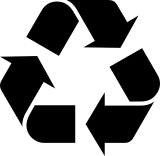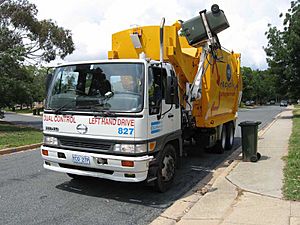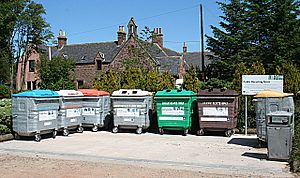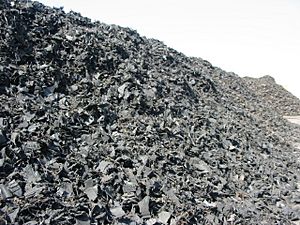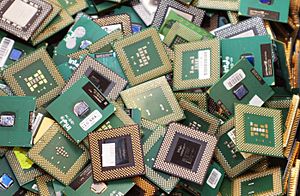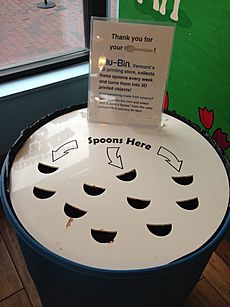Recycling facts for kids
Recycling is the process of converting waste materials into new materials and objects. It is an alternative to "conventional" waste disposal that can save material and help lower greenhouse gas emissions. Recycling can prevent the waste of potentially useful materials and reduce the consumption of fresh raw materials, thereby reducing: energy usage, air pollution (from incineration), and water pollution (from landfilling).
Recycling is a key component of modern waste reduction and is the third component of the "Reduce, Reuse, and Recycle" waste hierarchy. Thus, recycling aims at environmental sustainability by substituting raw material inputs into and redirecting waste outputs out of the economic system.
There are some ISO standards related to recycling such as ISO 15270:2008 for plastics waste and ISO 14001:2015 for environmental management control of recycling practice.
Recyclable materials include many kinds of glass, paper, cardboard, metal, plastic, tires, textiles, batteries, and electronics. The composting or other reuse of biodegradable waste—such as food or garden waste—is also a form of recycling. Materials to be recycled are either delivered to a household recycling center or picked up from curbside bins, then sorted, cleaned, and reprocessed into new materials destined for manufacturing new products.
In the strictest sense, recycling of a material would produce a fresh supply of the same material—for example, used office paper would be converted into new office paper or used polystyrene foam into new polystyrene. This is accomplished when recycling certain types of materials, such as metal cans, which can become a can again and again, infinitely, without losing purity in the product. However, this is often difficult or too expensive (compared with producing the same product from raw materials or other sources), so "recycling" of many products or materials involves their reuse in producing different materials (for example, paperboard) instead. Another form of recycling is the salvage of certain materials from complex products, either due to their intrinsic value (such as lead from car batteries, or gold from printed circuit boards), or due to their hazardous nature (e.g., removal and reuse of mercury from thermometers and thermostats).
History
Origins
Recycling has been a common practice for most of human history, with recorded advocates as far back as Plato in the fourth century BC. During periods when resources were scarce and hard to come by, archaeological studies of ancient waste dumps show less household waste (such as ash, broken tools, and pottery)—implying more waste was being recycled in the absence of new material.
In pre-industrial times, there is evidence of scrap bronze and other metals being collected in Europe and melted down for perpetual reuse. Paper recycling was first recorded in 1031 when Japanese shops sold repulped paper. In Britain dust and ash from wood and coal fires was collected by "dustmen" and downcycled as a base material used in brick making. The main driver for these types of recycling was the economic advantage of obtaining recycled feedstock instead of acquiring virgin material, as well as a lack of public waste removal in ever more densely populated areas. In 1813, Benjamin Law developed the process of turning rags into "shoddy" and "mungo" wool in Batley, Yorkshire. This material combined recycled fibers with virgin wool. The West Yorkshire shoddy industry in towns such as Batley and Dewsbury lasted from the early 19th century to at least 1914.
Industrialization spurred demand for affordable materials; aside from rags, ferrous scrap metals were coveted as they were cheaper to acquire than virgin ore. Railroads both purchased and sold scrap metal in the 19th century, and the growing steel and automobile industries purchased scrap in the early 20th century. Many secondary goods were collected, processed and sold by peddlers who scoured dumps and city streets for discarded machinery, pots, pans, and other sources of metal. By World War I, thousands of such peddlers roamed the streets of American cities, taking advantage of market forces to recycle post-consumer materials back into industrial production.
Beverage bottles were recycled with a refundable deposit at some drink manufacturers in Great Britain and Ireland around 1800, notably Schweppes. An official recycling system with refundable deposits was established in Sweden for bottles in 1884 and aluminum beverage cans in 1982; the law led to a recycling rate for beverage containers of 84–99 percent depending on type, and a glass bottle can be refilled over 20 times on average.
Wartime



New chemical industries created in the late 19th century both invented new materials (e.g. Bakelite [1907]) and promised to transform valueless into valuable materials. Proverbially, you could not make a silk purse of a sow's ear—until the US firm Arthur D. Little published in 1921 "On the Making of Silk Purses from Sows' Ears", its research proving that when "chemistry puts on overalls and gets down to business ... new values appear. New and better paths are opened to reach the goals desired."
Recycling (or "salvage", as it was then usually known) was a major issue for governments throughout World War II. Financial constraints and significant material shortages due to war efforts made it necessary for countries to reuse goods and recycle materials. These resource shortages caused by the world wars, and other such world-changing occurrences, greatly encouraged recycling. The struggles of war claimed much of the material resources available, leaving little for the civilian population. It became necessary for most homes to recycle their waste, as recycling offered an extra source of materials allowing people to make the most of what was available to them. Recycling household materials meant more resources for war efforts and a better chance of victory. Massive government promotion campaigns, such as the National Salvage Campaign in Britain and the Salvage for Victory campaign in the United States, were carried out on the home front in every combative nation, urging citizens to donate metal, paper, rags, and rubber as a matter of patriotism.
Post-World War II
A considerable investment in recycling occurred in the 1970s, due to rising energy costs. Recycling aluminum uses only 5% of the energy required by virgin production; glass, paper and other metals have less dramatic but very significant energy savings when recycled feedstock is used.
Although consumer electronics such as the television have been popular since the 1920s, recycling of them was almost unheard of until early 1991. The first electronic waste recycling scheme was implemented in Switzerland, beginning with collection of old refrigerators but gradually expanding to cover all devices. After these schemes were set up, many countries did not have the capacity to deal with the sheer quantity of e-waste they generated or its hazardous nature. They began to export the problem to developing countries without enforced environmental legislation. This is cheaper, as recycling computer monitors in the United States costs 10 times more than in China. Demand in Asia for electronic waste began to grow when scrap yards found that they could extract valuable substances such as copper, silver, iron, silicon, nickel, and gold, during the recycling process. The 2000s saw a large increase in both the sale of electronic devices and their growth as a waste stream: in 2002, e-waste grew faster than any other type of waste in the EU. This caused investment in modern, automated facilities to cope with the influx of redundant appliances, especially after strict laws were implemented in 2003.
In 2018, changes in the recycling market have sparked a global "crisis" in the industry. On December 31, 2017, China announced its "National Sword" policy, setting new standards for imports of recyclable material and banning materials that were deemed too "dirty" or "hazardous". The new policy caused drastic disruptions in the global market in recycling and reduced the prices of scrap plastic and low-grade paper. Exports of recyclable materials from G7 countries to China dropped dramatically, with many exports shifting to countries in southeast Asia. The crisis generated significant concern about the practices and environmental sustainability of the recycling industry. The abrupt shift caused countries to accept more recyclable materials than they could process, raising fundamental questions about shipping recycling waste from economically developed countries to countries with few environmental regulations—a practice that predated the crisis.
Recyclates
"Recyclate" is a raw material that is sent to, and processed in a waste recycling plant or materials recovery facility which will be used to form new products. The material is collected in various methods and delivered to a facility where it undergoes re-manufacturing so that it can be used in the production of new materials or products. For example, plastic bottles that are collected can be re-used and made into plastic pellets, a new product.
Quality of recyclate
The quality of recyclates is recognized as one of the principal challenges that needs to be addressed for the success of a long-term vision of a green economy and achieving zero waste. Recyclate quality is generally referring to how much of the raw material is made up of target material compared to the amount of non-target material and other non-recyclable material. For example, steel and metal are materials with a higher recyclate quality. It’s estimated that two thirds of all new steel manufactured comes from recycled steel. Only target material is likely to be recycled, so a higher amount of non-target and non-recyclable material will reduce the quantity of recycling product. A high proportion of non-target and non-recyclable material can make it more difficult for re-processors to achieve "high-quality" recycling. If the recyclate is of poor quality, it is more likely to end up being down-cycled or, in more extreme cases, sent to other recovery options or landfilled. For example, to facilitate the re-manufacturing of clear glass products there are tight restrictions for colored glass going into the re-melt process. Another example is the downcycling of plastic, in which products such as plastic food packaging are often downcycled into lower quality products, and do not get recycled into the same plastic food packaging.
The quality of recyclate not only supports high-quality recycling, but it can also deliver significant environmental benefits by reducing, reusing and keeping products out of landfills. High-quality recycling can help support growth in the economy by maximizing the economic value of the waste material collected. Higher income levels from the sale of quality recyclates can return value which can be significant to local governments, households, and businesses. Pursuing high-quality recycling can also provide consumer and business confidence in the waste and resource management sector and may encourage investment in that sector.
There are many actions along the recycling supply chain that can influence and affect the material quality of recyclate. It begins with the waste producers who place non-target and non-recyclable wastes in recycling collection. This can affect the quality of final recyclate streams or require further efforts to discard those materials at later stages in the recycling process. The different collection systems can result in different levels of contamination. Depending on which materials are collected together, extra effort is required to sort this material back into separate streams and can significantly reduce the quality of the final product. Transportation and the compaction of materials can make it more difficult to separate material back into separate waste streams. Sorting facilities are not one hundred per cent effective in separating materials, despite improvements in technology and quality recyclate which can see a loss in recyclate quality. The storage of materials outside, where the product can become wet, can cause problems for re-processors. Reprocessing facilities may require further sorting steps to further reduce the amount of non-target and non-recyclable material. Each action along the recycling path plays a part in the quality of recyclate.
Quality recyclate action plan (Scotland)
The Recyclate Quality Action Plan of Scotland sets out a number of proposed actions that the Scottish Government would like to take forward in order to drive up the quality of the materials being collected for recycling and sorted at materials recovery facilities before being exported or sold on to the reprocessing market.
The plan's objectives are to:
- Drive up the quality of recyclate
- Deliver greater transparency about the quality of recyclate
- Provide help to those contracting with materials recycling facilities to identify what is required of them
- Ensure compliance with the Waste (Scotland) regulations 2012
- Stimulate a household market for quality recyclate
- Address and reduce issues surrounding the Waste Shipment Regulations
The plan focuses on three key areas, with fourteen actions which were identified to increase the quality of materials collected, sorted and presented to the processing market in Scotland.
The three areas of focus are:
- Collection systems and input contamination
- Sorting facilities – material sampling and transparency
- Material quality benchmarking and standards
Recycling consumer waste
Collection
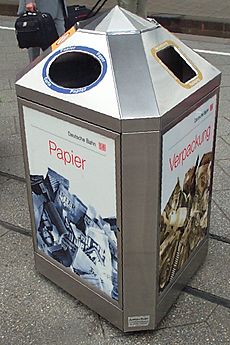
A number of different systems have been implemented to collect recyclates from the general waste stream. These systems lie along the spectrum of trade-off between public convenience and government ease and expense. The three main categories of collection are "drop-off centers", "buy-back centers", and "curbside collection".
Curbside collection
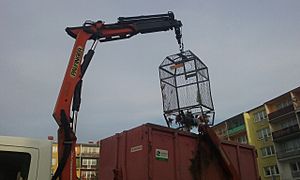
Curbside collection encompasses many subtly different systems, which differ mostly on where in the process the recyclates are sorted and cleaned. The main categories are mixed waste collection, commingled recyclables, and source separation. A waste collection vehicle generally picks up the waste.
At one end of the spectrum is mixed waste collection, in which all recyclates are collected mixed in with the rest of the waste, and the desired material is then sorted out and cleaned at a central sorting facility. This results in a large amount of recyclable waste, paper especially, being too soiled to reprocess, but has advantages as well: the city need not pay for a separate collection of recyclates and no public education is needed. Any changes to which materials are recyclable is easy to accommodate as all sorting happens in a central location.
In a commingled or single-stream system, all recyclables for collection are mixed but kept separate from other waste. This greatly reduces the need for post-collection cleaning but does require public education on what materials are recyclable.
Source separation
Source separation is the other extreme, where each material is cleaned and sorted prior to collection. This method requires the least post-collection sorting and produces the purest recyclates, but incurs additional operating costs for collection of each separate material. An extensive public education program is also required, which must be successful if recyclate contamination is to be avoided. In Oregon, USA, its environmental authority Oregon DEQ surveyed multi-family property managers and about half of them reported problems including contamination of recyclables due to trespassers such as transients gaining access to the collection areas.
Source separation used to be the preferred method due to the high sorting costs incurred by commingled (mixed waste) collection. However, advances in sorting technology have lowered this overhead substantially. Many areas which had developed source separation programs have since switched to what is called co-mingled collection.
Buy-back centers
Buy-back centers differ in that the cleaned recyclates are purchased, thus providing a clear incentive for use and creating a stable supply. The post-processed material can then be sold. If this is profitable, this conserves the emission of greenhouse gases; if unprofitable, it increases the emission of greenhouse gasses. Government subsidies are necessary to make buy-back centres a viable enterprise. In 1993, according to the U.S. National Waste & Recycling Association, it costs on average $50 to process a ton of material, which can be resold for $30.
In the US, the value per ton of mixed recyclables was $180 in 2011, $80 in 2015, and $100 in 2017.
In 2017, glass is essentially valueless, because of the low cost of sand, its major component; low oil costs thwarts plastic recycling.
In 2017, Napa, California was reimbursed about 20% of its costs in recycling.
Drop-off centers
Drop-off centers require the waste producer to carry the recyclates to a central location, either an installed or mobile collection station or the reprocessing plant itself. They are the easiest type of collection to establish but suffer from low and unpredictable throughput.
Distributed recycling
For some waste materials such as plastic, recent technical devices called recyclebots enable a form of distributed recycling. Preliminary life-cycle analysis (LCA) indicates that such distributed recycling of HDPE to make filament of 3D printers in rural regions is energetically favorable to either using virgin resin or conventional recycling processes because of reductions in transportation energy.
Sorting
Once commingled recyclates are collected and delivered to a materials recovery facility, the different types of materials must be sorted. This is done in a series of stages, many of which involve automated processes such that a truckload of material can be fully sorted in less than an hour. Some plants can now sort the materials automatically, known as single-stream recycling. Automatic sorting may be aided by robotics and machine-learning. In plants, a variety of materials is sorted such as paper, different types of plastics, glass, metals, food scraps, and most types of batteries. A 30 percent increase in recycling rates has been seen in the areas where these plants exist. In the United States, there are over 300 materials recovery facilities.
Initially, the commingled recyclates are removed from the collection vehicle and placed on a conveyor belt spread out in a single layer. Large pieces of corrugated fiberboard and plastic bags are removed by hand at this stage, as they can cause later machinery to jam.

Next, automated machinery such as disk screens and air classifiers separate the recyclates by weight, splitting lighter paper and plastic from heavier glass and metal. Cardboard is removed from the mixed paper and the most common types of plastic, PET (#1) and HDPE (#2), are collected. This separation is usually done by hand but has become automated in some sorting centers: a spectroscopic scanner is used to differentiate between different types of paper and plastic based on the absorbed wavelengths, and subsequently divert each material into the proper collection channel.
Strong magnets are used to separate out ferrous metals, such as iron, steel, and tin cans. Non-ferrous metals are ejected by magnetic eddy currents in which a rotating magnetic field induces an electric current around the aluminum cans, which in turn creates a magnetic eddy current inside the cans. This magnetic eddy current is repulsed by a large magnetic field, and the cans are ejected from the rest of the recyclate stream.
Finally, glass is sorted according to its color: brown, amber, green, or clear. It may either be sorted by hand, or via an automated machine that uses colored filters to detect different colors. Glass fragments smaller than 10 millimetres (0.39 in) across cannot be sorted automatically, and are mixed together as "glass fines".
This process of recycling as well as reusing the recycled material has proven advantageous because it reduces amount of waste sent to landfills, conserves natural resources, saves energy, reduces greenhouse gas emissions, and helps create new jobs. Recycled materials can also be converted into new products that can be consumed again, such as paper, plastic, and glass.
The City and County of San Francisco's Department of the Environment is attempting to achieve a citywide goal of generating zero waste by 2020. San Francisco's refuse hauler, Recology, operates an effective recyclables sorting facility which helped the city reach a record-breaking diversion rate of 80%.
Recycling industrial waste
Although many government programs are concentrated on recycling at home, 64% of waste in the United Kingdom is generated by industry. The focus of many recycling programs done by industry is the cost–effectiveness of recycling. The ubiquitous nature of cardboard packaging makes cardboard a commonly recycled waste product by companies that deal heavily in packaged goods, like retail stores, warehouses, and distributors of goods. Other industries deal in niche or specialized products, depending on the nature of the waste materials that are present.
The glass, lumber, wood pulp and paper manufacturers all deal directly in commonly recycled materials; however, old rubber tires may be collected and recycled by independent tire dealers for a profit.
Levels of metals recycling are generally low. In 2010, the International Resource Panel, hosted by the United Nations Environment Programme (UNEP) published reports on metal stocks that exist within society and their recycling rates. The Panel reported that the increase in the use of metals during the 20th and into the 21st century has led to a substantial shift in metal stocks from below ground to use in applications within society above ground. For example, the in-use stock of copper in the USA grew from 73 to 238 kg per capita between 1932 and 1999.
The report authors observed that, as metals are inherently recyclable, the metal stocks in society can serve as huge mines above ground (the term "urban mining" has been coined with this idea in mind). However, they found that the recycling rates of many metals are very low. The report warned that the recycling rates of some rare metals used in applications such as mobile phones, battery packs for hybrid cars and fuel cells, are so low that unless future end-of-life recycling rates are dramatically stepped up these critical metals will become unavailable for use in modern technology.
The military recycles some metals. The U.S. Navy's Ship Disposal Program uses ship breaking to reclaim the steel of old vessels. Ships may also be sunk to create an artificial reef. Uranium is a very dense metal that has qualities superior to lead and titanium for many military and industrial uses. The uranium left over from processing it into nuclear weapons and fuel for nuclear reactors is called depleted uranium, and is used by all branches of the U.S. military for the development of such things as armour-piercing shells and shielding.
The construction industry may recycle concrete and old road surface pavement, selling their waste materials for profit.
Some industries, like the renewable energy industry and solar photovoltaic technology, in particular, are being proactive in setting up recycling policies even before there is considerable volume to their waste streams, anticipating future demand during their rapid growth.
Recycling of plastics is more difficult, as most programs are not able to reach the necessary level of quality. Recycling of PVC often results in downcycling of the material, which means only products of lower quality standard can be made with the recycled material. A new approach which allows an equal level of quality is the Vinyloop process. It was used after the London Olympics 2012 to fulfill the PVC Policy.
E-waste recycling
E-waste is a growing problem, accounting for 20–50 million metric tons of global waste per year according to the EPA. It is also the fastest growing waste stream in the EU. Many recyclers do not recycle e-waste responsibly. After the cargo barge Khian Sea dumped 14,000 metric tons of toxic ash in Haiti, the Basel Convention was formed to stem the flow of hazardous substances into poorer countries. They created the e-Stewards certification to ensure that recyclers are held to the highest standards for environmental responsibility and to help consumers identify responsible recyclers. This works alongside other prominent legislation, such as the Waste Electrical and Electronic Equipment Directive of the EU the United States National Computer Recycling Act, to prevent poisonous chemicals from entering waterways and the atmosphere.
In the recycling process, television sets, monitors, cell phones, and computers are typically tested for reuse and repaired. If broken, they may be disassembled for parts still having high value if labor is cheap enough. Other e-waste is shredded to pieces roughly 10 centimetres (3.9 in) in size, and manually checked to separate out toxic batteries and capacitors which contain poisonous metals. The remaining pieces are further shredded to 10 millimetres (0.39 in) particles and passed under a magnet to remove ferrous metals. An eddy current ejects non-ferrous metals, which are sorted by density either by a centrifuge or vibrating plates. Precious metals can be dissolved in acid, sorted, and smelted into ingots. The remaining glass and plastic fractions are separated by density and sold to re-processors. Television sets and monitors must be manually disassembled to remove lead from CRTs or the mercury backlight from LCDs.
Plastic recycling
Plastic recycling is the process of recovering scrap or waste plastic and reprocessing the material into useful products, sometimes completely different in form from their original state. For instance, this could mean melting down soft drink bottles and then casting them as plastic chairs and tables. For some types of plastic, the same piece of plastic can only be recycled about 2-3 times before its quality decreases to the point where it can no longer be used.
Physical recycling
Some plastics are remelted to form new plastic objects; for example, PET water bottles can be converted into polyester destined for clothing. A disadvantage of this type of recycling is that the molecular weight of the polymer can change further and the levels of unwanted substances in the plastic can increase with each remelt.
Chemical recycling
For some polymers, it is possible to convert them back into monomers, for example, PET can be treated with an alcohol and a catalyst to form a dialkyl terephthalate. The terephthalate diester can be used with ethylene glycol to form a new polyester polymer, thus making it possible to use the pure polymer again. In 2019, Eastman Chemical Company announced initiatives of methanolysis and syngas designed to handle a greater variety of used material.
Waste plastic pyrolysis to fuel oil
Another process involves the conversion of assorted polymers into petroleum by a much less precise thermal depolymerization process. Such a process would be able to accept almost any polymer or mix of polymers, including thermoset materials such as vulcanized rubber tires and the biopolymers in feathers and other agricultural waste. Like natural petroleum, the chemicals produced can be used as fuels or as feedstock. A RESEM Technology plant of this type in Carthage, Missouri, US, uses turkey waste as input material. Gasification is a similar process but is not technically recycling since polymers are not likely to become the result. Plastic Pyrolysis can convert petroleum based waste streams such as plastics into quality fuels, carbons. Given below is the list of suitable plastic raw materials for pyrolysis:
- Mixed plastic (HDPE, LDPE, PE, PP, Nylon, Teflon, PS, ABS, FRP, etc.)
- Mixed waste plastic from waste paper mill
- Multi-layered plastic
Recycling loops
The (ideal) recycling process can be differentiated into three loops, one for manufacture (production-waste recycling) and two for disposal of the product (product and material recycling).
The product's manufacturing phase, which consists of material processing and fabrication, forms the production-waste recycling loop. Industrial waste materials are fed back into, and reused in, the same production process.
The product's disposal process requires two recycling loops: product recycling and material recycling. The product or product parts are reused in the product recycling phase. This happens in one of two ways: the product is used retaining the product functionality ("reuse") or the product continues to be used but with altered functionality ("further use"). The product design is unmodified, or only slightly modified, in both scenarios.
Product disassembly requires material recycling where product materials are recovered and recycled. Ideally, the materials are processed so they can flow back into the production process.
Recycling codes
In order to meet recyclers' needs while providing manufacturers a consistent, uniform system, a coding system was developed. The recycling code for plastics was introduced in 1988 by the plastics industry through the Society of the Plastics Industry. Because municipal recycling programs traditionally have targeted packaging—primarily bottles and containers—the resin coding system offered a means of identifying the resin content of bottles and containers commonly found in the residential waste stream.
Plastic products are printed with numbers 1–7 depending on the type of resin. Type 1 (polyethylene terephthalate) is commonly found in soft drink and water bottles. Type 2 (high-density polyethylene) is found in most hard plastics such as milk jugs, laundry detergent bottles, and some dishware. Type 3 (polyvinyl chloride) includes items such as shampoo bottles, shower curtains, hula hoops, credit cards, wire jacketing, medical equipment, siding, and piping. Type 4 (low-density polyethylene) is found in shopping bags, squeezable bottles, tote bags, clothing, furniture, and carpet. Type 5 is polypropylene and makes up syrup bottles, straws, Tupperware, and some automotive parts. Type 6 is polystyrene and makes up meat trays, egg cartons, clamshell containers, and compact disc cases. Type 7 includes all other plastics such as bulletproof materials, 3- and 5-gallon water bottles, cell phone and tablet frames, safety goggles and sunglasses. Having a recycling code or the chasing arrows logo on a material is not an automatic indicator that a material is recyclable but rather an explanation of what the material is. Types 1 and 2 are the most commonly recycled.
Related pages
Images for kids
-
Some people in Brazil earn their living by collecting and sorting garbage and selling them for recycling.
See also
 In Spanish: Reciclaje para niños
In Spanish: Reciclaje para niños


